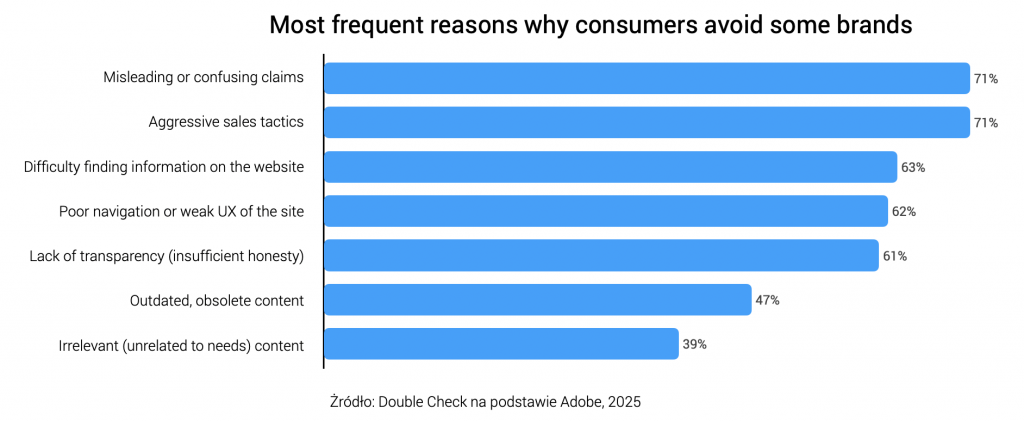The latest Adobe research sheds light on why consumers consciously avoid buying from certain brands.It turns out that certain actions and neglect by companies effectively alienate customers, negatively affecting their experiences and loyalty. As many as 71% of consumers declare avoiding a brand because of unfulfilled promises or misleading marketing claims, the same number (71%) point to aggressive sales tactics, and 63% complain about difficulty finding the information they need on a brand’s website. Other significant reasons for frustration include poor navigation or site design, lack of transparency in communication with the customer, outdated information, and content irrelevant to the recipient. Below is a detailed analysis of these most common errors by brands and a discussion of their impact oncustomer experience, consumer loyalty and campaign effectiveness.

As the above ranking shows, misleading communications and aggressive sales approaches are among brands’ most serious offenses – each of these categories was indicated by as many as 71% of respondents. Close behind them are problems related to the experience on the brand’s website: for 63% of respondents the barrier is the lack of easily accessible information, and 62% are discouraged by poor navigation and an overall poorly designed user interface. Lack of transparency in the company’s operations bothers 61% of consumers, while issues of content freshness and relevance – such as outdated messages or inappropriate content – are negatively perceived by 47% and 39% of respondents, respectively.
Recommendations for marketers
Strategic analysis of errors shows that irritating marketing practices directly translate into worsened customer experience, decreased consumer loyalty and lower effectiveness of media activities. In an age of demanding, conscious consumers, such losses are a luxury that brands cannot afford. Below are key recommendations that will help marketers avoid the most common missteps and maintain positive customer engagement:
- Let’s focus on honesty and transparency
Let’s eliminate all misleading messages. Promises made in advertising communication must be matched by reality (products, offers). Avoid catchyslogans that may mislead. Instead, communicate a real value proposition. Provide full transparency: clearly informing about prices, terms of promotion and additional costs – so that the customer does not feel surprised by anything. Honest communication builds trust, which is the foundation of loyalty.
- Let’s giveup pushiness in favor of personalization
Aggressive sales tactics should be replaced by a customer‑oriented approach. Let’s limit the frequency and invasiveness of marketing messages to a level acceptable to the recipient. Instead of bombarding everyone with the same message, segment audiences andprovide them with personalised content of real value. Adobe’s research shows that consumers prefer an authentic dialogue with the brand – brands that overuse promotions “by force” risk losing as much as 71% of potential customers. Abetter approach is to listen to the customer and respond to their expectations, which translates into more effective campaigns.
- Let’s optimise the experience on the site
Let’s make sure that the website or application works like the best salesperson, not like a hidden maze. Let’s carryout a usability audit: are key information (product description, price, availability, delivery conditions, contact) easily accessible in a few clicks? Let’s improve navigation, simplify the menu structure, add a search engine – anything that will make it easier for the customer to find whatthey need. Let’s ensure responsiveness and fast operation of the site. Investment in good UX will translate into a lower bounce rate and higher conversion, especially in older customer segments for whom intuitiveness is key.
- Let’s update and curate content
Let’s implement procedures for regularly reviewing content on all of the brand’s channels (website, blog, social media). Remove or update outdated information – nothing undermines credibility more than an outdated offer or a long‑unseen blog post. Create content relevant from the audience’s perspective: before publishing anything,ask whether it is useful for our target group. Inthe age of information overload, consumers reject anything that deviates from their needs. A consistent and up‑to‑date content strategy – referred to by Adobe as the pursuit of “flawless consistency” – helps avoid situations where the customer receives contradictory or irrelevant messages. It is also worthwhile to monitor users’ reactions and refine the message on that basis.
Brands that want to maintain a competitive advantage must take care of every aspect of the customer experience – from reliable marketing communication to the ease of using digital channels. Neglect and irritating practices described above pose a real threat: they can lead to the loss of even more than two thirds of potential customers, who will choose the competition if they feel disappointed or irritated. Building loyalty and a positive image requires eliminating sources of frustration – only then will media campaigns achieve full effectiveness, and the relationship with the customer will be based on a solid foundation of trust and satisfaction.